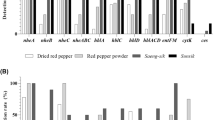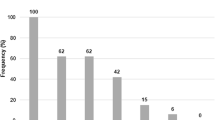Abstract—Bacillus cereus is a spore-forming bacterium found in the environment mainly in soil. Bacillus spores are known to be extremely resistant not only to environmental factors, but also to various sanitation regimes. This leads to spore contamination of toxin-producing strains in hospital and food equipment and, therefore, poses a great threat to human health. Two clinical isolates identified as B. cereus and B. cytotoxicus were used in the present work. It was shown that their calcium ion content was significantly lower than that of the reference strains. According to electron microscopy, one of the SRCC 19/16 isolates has an enlarged exosporium, and the SRCC 1208 isolate has large electron-dense inclusions of an unclear nature during sporulation. We can assume that these contain a biologically active component with a cytotoxic effect and possibly play a role in pathogenesis. Comparative chemical, biochemical, physiological, and ultrastructural analysis of spores of clinical isolates and reference strains of B. cereus was performed. The results we obtained deepen our understanding of the properties of spores that contribute to the increased pathogenicity of B. cereus group species.






Similar content being viewed by others
REFERENCES
Savini V. 2016. In The Diverse Faces of Bacillus cereus. Savini V., Ed. Elsvier: Academic Press, pp. 73–84.
Kuroki R., Kawakami K., Qin L., Kaji C., Watanabe K., Kimura Y., Ishiguro C., Tanimura S., Tsuchiya Y., Hamaguchi I., Sakakura M., Sakabe S., Tsuji K., Inoue M., Watanabe H. 2009. Nosocomial bacteremia caused by biofilm-forming Bacillus cereus and Bacillus thuringiensis. Intern. Med. 48 (10), 791–796.
Elshaghabee F.M.F., Rokana N., Gulhane R.D., Sharma C., Panwar H. 2017. Bacillus as potential probiotics: status, concerns, and future perspectives. Front. Microbiol. 8, 1490.
Bundy J.G., Willey T.L., Castell R.S., Ellar D.J., Brindle K.M. 2005. Discrimination of pathogenic clinical isolates and laboratory strains of Bacillus cereus by NMR-based metabolomic profiling. FEMS Microbiol. Lett. 242 (1), 127–136.
Smirnova T.A., Zubasheva M.V., Shevlyagina N.V., Nikolaenko M.A., Azizbekyan R.R. 2013. Electron microscopy of the surfaces of Bacillus spores. Microbiology. 82 (6), 713–720.
Stewart G.C. 2015. The exosporium layer of bacterial spores: a connection to the environment and the infected host. Microbiol. Mol. Biol. Rev. 79 (4), 437–457.
Ball D.A., Taylor R., Todd S.J., Redmond C., Couture-Tosi E., Sylvestre P., Moir A., Bullough P.A. 2008. Structure of the exosporium and sublayers of spores of the Bacillus cereus family revealed by electron crystallography. Mol. Microbiol. 68 (4), 947–958.
Smirnova T.A., Poglazova M.N., Nikolaenko M.A., Azizbekyan R.R. 2000. The adhesion characteristics of Bacillus thuringiensis. Biotechnologia. 3, 16–26.
Hoa N.T., Baccigalupi L., Huxham A., Smertenko A., Van P.H., Ammendola S., Ricca E., Cutting A.S. 2000. Characterization of Bacillus species used for oral bacteriotherapy and bacterioprophylaxis of gastrointestinal disorders. Appl. Environ. Microbiol. 66 (12), 5241–5247.
Daffonchio D., Raddadi N., Merabishvili M., Cherif A., Carmagnola L., Brusetti L., Rizzi A., Chanishvili N., Visca P., Sharp R., Borin S. 2006. Strategy for identification of Bacillus cereus and Bacillus thuringiensis strains closely related to Bacillus anthracis. Appl. Environ. Microbiol. 72 (2), 1295–1301.
Chelliah R., Wei S., Park B.J., Kim S.H., Park D.S., Kim S.H., Hwan K.S., Oh D.H. 2017. Novel motB as a potential predictive tool for identification of B. cereus, B. thuringiensis and differentiation from other Bacillus species by triplex real-time PCR. Microb. Pathog. 111, 22–27.
Olsen J.S., Skogan G., Fykse E.M., Rawlinson E.L., Tomaso H., Granum P.E., Blatny J.M. 2007. Genetic distribution of 295 Bacillus cereus group members based on adk-screening in combination with MLST (Multilocus Sequence Typing) used for validating a primer targeting a chromosomal locus in B. anthracis. J. Microbiol. Methods. 71 (3), 265–274.
Phillips A.P., Ezzell J.W. 1989. Identification of Bacillus anthracis by polyclonal antibodies against extracted vegetative cell antigens. J. Appl. Bacteriol. 66 (5), 419–432.
Clark A.E., Kaleta E.J., Arora A., Wolk D.M. 2013. Matrix-assisted laser desorption ionization-time of flight mass spectrometry: a fundamental shift in the routine practice of clinical microbiology. Clin. Microbiol. Rev. 26 (3), 547–603.
Keys C.J., Dare D.J., Sutton H., Wells G., Lunt M., McKenna T., McDowall M., Shah H.N. 2004. Compilation of a MALDI-TOF mass spectral database for the rapid screening and characterisation of bacteria implicated in human infectious diseases. Infect. Genet. Evol. 4 (3), 221–242.
Laue M., Fulda G. 2013. Rapid and reliable detection of bacterial endospores in environmental samples by diagnostic electron microscopy combined with X-ray microanalysis. J. Microbiol. Methods. 94 (1), 13–21.
Vasil'chenko A.S., Yarullina D.R., Nikiyan A.N., Teslya A.V. 2012. Morphofunctional characteristics of Bacillus cereus bacteria at different stages of the life cycle. Vestn. Orenburg. Gos. Univ. 10 (146), 66–71.
Kim K., Seo J., Wheeler K., Park C., Kim D., Park S., Kim W., Chung S.I., Leighton T. 2005. Rapid genotypic detection of Bacillus anthracis and the Bacillus cereus group by multiplex real-time PCR melting curve analysis. FEMS Immunol. Med. Microbiol. 43 (2), 301–310.
Abriouel H., Ben Omar N., Lucas Lopez R., Martinez Canamero M., Ortega E., Galvez A. 2007. Differentiation and characterization by molecular techniques of Bacillus cereus group isolates from poto poto and degue, two traditional cereal-based fermented foods of Burkina Faso and Republic of Congo. J. Food Prot. 70 (5), 1165–1173.
Hsieh Y.M., Sheu S.J., Chen Y.L., Tsen H.Y. 1999. Enterotoxigenic profiles and polymerase chain reaction detection of Bacillus cereus group cells and B. cereus strains from foods and food-borne outbreaks. J. Appl. Microbiol. 87 (4), 481–490.
Oliwa-Stasiak K., Molnar C.I., Arshak K., Bartoszcze M., Adley C.C. 2010. Development of a PCR assay for identification of the Bacillus cereus group species. J. App-l. Microbiol. 108 (1), 266–273.
Ehling-Schulz M., Svensson B., Guinebretiere M.H., Lindback T., Andersson M., Schulz A., Fricker M., Christiansson A., Granum P.E., Martlbauer E., Nguyen-The C., Salkinoja-Salonen M., Scherer S. 2005. Emetic toxin formation of Bacillus cereus is restricted to a single evolutionary lineage of closely related strains. Microbiology (Reading). 151 (Pt 1), 183–197.
Morgulis A., Coulouris G., Raytselis Y., Madden T.L., Agarwala R., Schaffer A.A. 2008. Database indexing for production MegaBLAST searches. Bioinformatics. 24 (16), 1757–1764.
Ito S. 1968. Formaldehyde–glutaraldehyde fixatives containing tri nitro compounds. J. Cell Biol. 39, 168A–169A.
Sauer S., Freiwald A., Maier T., Kube M., Reinhardt R., Kostrzewa M., Geider K. 2008. Classification and identification of bacteria by mass spectrometry and computational analysis. PLoS One. 3 (7), e2843.
Liu Y., Lai Q., Goker M., Meier-Kolthoff J.P., Wang M., Sun Y., Wang L., Shao Z. 2015. Genomic insights into the taxonomic status of the Bacillus cereus group. Sci. Rep. 5, 14082.
Pauker V.I., Thoma B.R., Grass G., Bleichert P., Hanczaruk M., Zoller L., Zange S. 2018. Improved discrimination of Bacillus anthracis from closely related species in the Bacillus cereus sensu lato group based on matrix-assisted laser desorption ionization-time of flight mass spectrometry. J. Clin. Microbiol. 56 (5), e01900–e01917.
Ha M., Jo H.J., Choi E.K., Kim Y., Kim J., Cho H.J. 2019. Reliable identification of Bacillus cereus group species using low mass biomarkers by MALDI-TOF MS. J. Microbiol. Biotechnol. 29 (6), 887–896.
Shu L.-J., Yang Y.-L. 2017. Bacillus classification based on matrix-assisted laser desorption ionization time-of-flight mass spectrometry—effects of culture conditions. Sci. Rep. 7 (1), 15546.
Bourque S.N., Valero J.R., Lavoie M.C., Levesque R.C. 1995. Comparative analysis of the 16S to 23S ribosomal intergenic spacer sequences of Bacillus thuringiensis strains and subspecies and of closely related species. App-l. Environ. Microbiol. 61 (4), 1623–1626.
Guinebretiere M.H., Auger S., Galleron N., Contzen M., De Sarrau B., De Buyser M.L., Lamberet G., Fagerlund A., Granum P.E., Lereclus D., De Vos P., Nguyen-The C., Sorokin A. 2013. Bacillus cytotoxicus sp. nov. is a novel thermotolerant species of the Bacillus cereus group occasionally associated with food poisoning. Int. J. Syst. Evol. Microbiol. 63 (Pt 1), 31–40.
Sinnela M.T., Pawluk A.M., Jin Y.H., Kim D., Mah J.H. 2021. Effect of calcium and manganese supplementation on heat resistance of spores of Bacillus species associated with food poisoning, spoilage, and fermentation. Front. Microbiol. 12, 744953.
Teplova V.V., Mikkola R., Tonshin A.A., Saris N.E., Salkinoja-Salonen M.S. 2006. The higher toxicity of cereulide relative to valinomycin is due to its higher affinity for potassium at physiological plasma concentration. Toxicol. Appl. Pharmacol. 210 (1–2), 39–46.
Osman G., Already R., Assaeedi A., Organji S., El-Ghareeb D., Abulreesh H., Althubiani A. 2015. Bioinsecticide Bacillus thuringiensis a comprehensive review. Egyptian J. Biol. Pest Control. 25, 271–288.
Yan M., Roehrl M.H., Wang J.Y. 2007. Discovery of crystalline inclusions in Bacillus licheniformis that resemble parasporal crystals of Bacillus thuringiensis. Can. J. Microbiol. 53 (9), 1111–1115.
Charles J.F., Nielson-LeRoux C., Delecluse A. 1996. Bacillus sphaericus toxins: molecular biology and mode of action. Annu. Rev. Entomol. 41, 451–472.
Park H.-W., Federici B., Sakano Y. 2006. In Inclusion Proteins from Other Insecticidal Bacteria. Shively Jessu-p M., Steinbüchel A., Eds. Berlin: Springer, pp. 321–330.
Mizuki E., Park Y.S., Saitoh H., Yamashita S., Akao T., Higuchi K., Ohba M. 2000. Parasporin, a human leukemic cell-recognizing parasporal protein of Bacillus thuringiensis. Clin. Diagn. Lab. Immunol. 7 (4), 625–634.
ACKNOWLEDGMENTS
The authors are grateful to Moiseenko A.V. for technical support, as well as Rubtsov A.V., Rubtsova K.V. and Zolotukhin M.S. for help in preparing the publication. The authors also express their gratitude to the Center for High Precision Genome Editing and Genetic Technologies for Biomedicine of the IMB RAS for the provided computing power and methods for data analysis.
Part of the work was performed on the equipment of the Genome Central Collective Use Center of the IMB RAS (http://www.eimb.ru/RUSSIAN_NEW/INSTITUTE/ccu_ genome_c.php).
Funding
The work was supported by the Ministry of Science and Higher Education of the Russian Federation (Contract in the electronic budget system no. 075-10-2021-113, project ID: RF----193021X0001).
Author information
Authors and Affiliations
Corresponding author
Ethics declarations
The authors declare that they have no conflicts of interest. This article does not contain any studies involving humans or animals as research subjects.
Additional information
Abbreviations: MALDI-TOF, matrix assisted laser desorption/ionization–time of flight; TEM, transmission electron microscopy; SEM, scanning electron microscopy; SEM-EDR, scanning electron microscopy–energy dispersive X-ray analysis; MLSA, multilocus sequence analysis; AFLP, amplified fragment length polymorphism.
Supplementary Information
Rights and permissions
About this article
Cite this article
Smirnova, T.A., Polyakov, N.B., Karpov, D.S. et al. Identification of Clinical Isolates of the Bacillus cereus Group and Their Characterization by Mass Spectrometry and Electron Microscopy. Mol Biol 57, 604–615 (2023). https://doi.org/10.1134/S0026893323040167
Received:
Revised:
Accepted:
Published:
Issue Date:
DOI: https://doi.org/10.1134/S0026893323040167




